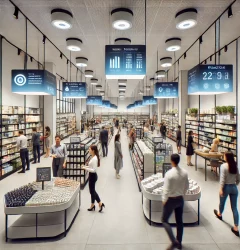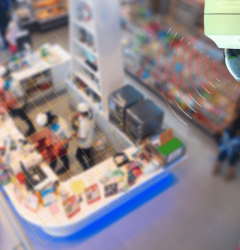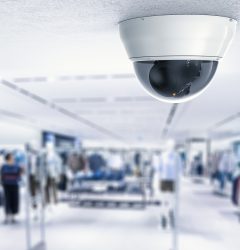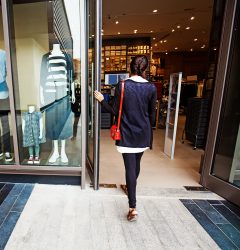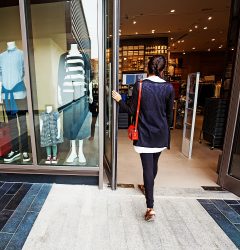14 Dec

Retail Foot Traffic: How Does People Counting Work?
Retail foot traffic can be a useful metric for businesses. It’s used to gauge how well the business is doing, whether it needs to hire more staff or adjust its marketing efforts. Retail foot traffic is often measured by counting the number of people who walk through the door over a given period of time. This can be done manually or automatically using sensors, but both methods have their drawbacks. Manual counting requires someone to sit in front of the door and count everyone that comes in; automated sensors are expensive and may not work well with certain types of doors depending on height, width, or other factors affecting their accuracy.
What Is the Concept of People Counting and Retail Foot Traffic?
People counting is a technology used to monitor traffic flow in retail stores and other public spaces. A person-counting system uses infrared detectors to detect the movement of individuals within an area, which is then counted and recorded by the system. People counting systems can be used for various purposes, including monitoring foot traffic at events or determining restaurant occupancy rates.
Why Does It Matter?
Foot traffic is an important metric for retailers. When you get your foot traffic counted, you can use that data to identify problems in your store and adjust accordingly. For example, if you notice that the aisles are too narrow or there’s not enough high-visibility signage, you’ll know to fix those issues so customers can easily find what they’re looking for. The knowledge gained from foot traffic counts will also help with marketing campaigns—if one particular campaign isn’t attracting many people into the store, then you can try a different strategy next time around.
Importance of retail traffic counters and store counting
Retail traffic counters are a vital part of any retail operation. They help you improve your store’s performance by tracking both in-store and online traffic and providing reports on those statistics. Retailers can use this data to better understand what their customers want, which in turn allows them to provide a better customer experience. This leads to more repeat customers who will spend more money and bring in new customers through word-of-mouth advertising. In other words, it’s all about getting people into the door! Traffic counters also allow retailers to more effectively market themselves by understanding how people find out about their business before they make a purchase decision—and being able to adjust accordingly based on that information.”
Top Benefits Of having shopper count and in-store traffic monitoring systems
Knowing your store’s passenger count can help you make better decisions about where to put your store and how to improve it. For example, if you have a smaller facility but see that traffic is increasing, then it may be worth investing in expanding or moving to a larger location. A shopper counting system will also help you understand how many people are using your store, what they’re buying, and for how long they spend in the store. This can be useful when planning promotions or deciding which products should be stocked on shelves so that customers will find them easily.
How retail store traffic counters can help you in your marketing campaign
Retail store traffic counters are designed to help you understand your customers and their shopping habits, which is crucial for any business. Analyzing the data collected by retail store traffic counters can give you a better idea of how your store compares to the competition, allowing you to make strategic decisions about pricing, marketing campaigns, and in-store promotions.
For example, notice that one of your competitors is offering deeper discounts than usual on a specific product category and see an increase in foot traffic at their stores during those times. It might be worthwhile for you to do the same thing. If this strategy works well for them but doesn’t seem to be paying off for either of them as far as sales are concerned (or if it doesn’t help either company), then perhaps they should consider trying something else instead.
How can you use foot traffic counting data to improve your store’s performance?
If you want to improve your business, the first thing to do is look at the data. Foot traffic counting data can help you monitor how customers are interacting with your brand and understand how they respond to specific marketing campaigns. You can use foot traffic counting data to determine if a campaign is working or not or if any changes need to be made. Foot traffic counts will also tell you how many people entered your store on a given day. This can be useful for determining whether or not certain promotions are effective in driving sales or if additional signage is needed near entrances or exits.
People counting is a mechanism for keeping track of the number of people who enter and exit your business on a given day.
People counting is a mechanism for keeping track of the number of people who enter and exit your business on a given day. Foot traffic data is used in many industries and has proven to be extremely useful when trying to understand customer behavior. For example, retail stores may want to know if certain products are selling well or not selling at all based on how many people enter the store and purchase items from those sections. If there aren’t enough sales coming from a certain area of the store, retailers may decide to promote that section more often through advertisements online or in print media designed specifically toward their target market demographic (i.e., moms).
Final Thoughts
The idea that one can measure how many people are coming into or leaving a store is a simple concept, but it has far-reaching implications for businesses. Knowing how many people come through your doors each day, you can use this data to decide where to focus your marketing efforts and other staffing needs. For example, if you notice that fewer customers are entering than exiting at certain times of the day or during certain seasons, then maybe it’s time to hire more sales associates during those hours to keep up with demand!
Related Post
Tags
Keywords
Tags
Resources
© 2020-2024 Link Retail. All rights reserved.
